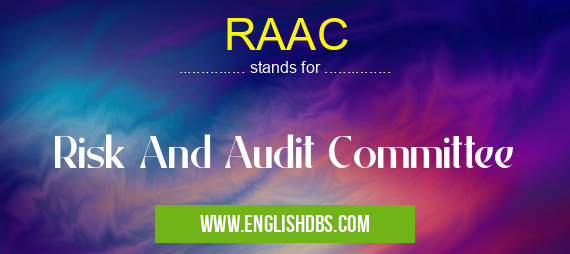What does RAAC mean in AUDITING
The RAAC is responsible for overseeing an organization's risk management and internal audit functions. It provides independent assurance to the board of directors and management that the organization has effective systems in place to identify, assess, and mitigate risks.

RAAC meaning in Auditing in Business
RAAC mostly used in an acronym Auditing in Category Business that means Risk And Audit Committee
Shorthand: RAAC,
Full Form: Risk And Audit Committee
For more information of "Risk And Audit Committee", see the section below.
Functions of a RAAC
- Risk Management:
- Reviews and assesses the organization's risk profile, including financial, operational, compliance, and reputational risks.
- Provides guidance on risk management policies and procedures.
- Monitors the effectiveness of risk mitigation strategies.
- Internal Audit:
- Oversees the internal audit function, ensuring its independence, objectivity, and effectiveness.
- Reviews internal audit reports and recommendations.
- Supports the organization's internal control system.
- Financial Reporting:
- Monitors the quality and accuracy of financial reporting.
- Reviews the organization's compliance with financial reporting standards.
- Provides assurance to stakeholders on the reliability of financial statements.
Composition of a RAAC
- Typically composed of independent and non-executive directors.
- May include external experts in risk management, internal audit, or accounting.
Benefits of a RAAC
- Enhanced Risk Management: Improved risk identification, assessment, and mitigation.
- Stronger Internal Audit: Independent and effective internal audit function.
- Improved Financial Reporting: Accurate and reliable financial statements.
- Increased Stakeholder Confidence: Assurance that risks are being managed and financial reporting is sound.
Essential Questions and Answers on Risk And Audit Committee in "BUSINESS»AUDITING"
What is the primary role of a Risk and Audit Committee (RAAC)?
What are the key responsibilities of a RAAC?
The RAAC's key responsibilities typically include:
- Reviewing and approving the organization's risk management framework and policies
- Monitoring the effectiveness of the organization's risk management and internal audit functions
- Reviewing internal audit reports and providing guidance to management
- Reporting to the board of directors on the adequacy and effectiveness of risk management and internal audit functions
What is the difference between a RAAC and an Audit Committee?
While both RAACs and Audit Committees oversee internal audit functions, RAACs have a broader scope that includes risk management. RAACs are responsible for ensuring that the organization has a comprehensive approach to risk management, while Audit Committees focus primarily on the financial reporting process and internal controls.
Who is typically involved in a RAAC?
RAACs typically consist of a mix of independent directors, senior management, and internal audit professionals. The specific composition of a RAAC may vary depending on the size and complexity of the organization.
What are the benefits of having a strong RAAC?
A strong RAAC can help an organization:
- Improve risk management practices
- Enhance the effectiveness of internal audit functions
- Increase transparency and accountability
- Build trust with stakeholders
Final Words:
- RAACs play a vital role in safeguarding an organization's interests by providing independent oversight of risk management and internal audit functions.
- By effectively fulfilling their responsibilities, RAACs contribute to strong corporate governance, financial transparency, and sustainable growth.
RAAC also stands for: |
|
| All stands for RAAC |
